
Have you just started your dream business, or have been already running it for several years but experiencing low traffic to your site?
That’s a typical issue many businesses face, in fact, according to Ahrefs research from the last year, a significant 91% of content got 0 traffic from Google, and only the top 10 companies have been rewarded with organic first-page results. Where 3 of them regularly are Google paid ads.
The question is, how do you make sure that your content ranks well, gets the traffic, and competes well on the first Google pages?
Luckily that’s where keyword research for content SEO comes into play and it’s one of the most important steps to business success that cannot be ignored.
Today, you’ll learn more about keyword research for SEO and what are the top techniques to build a winning strategy. Also, you’ll learn a step-by-step process of how to create your first keyword research strategy and what tools to use.
So stay tuned!
Keyword Research Basics
What’s keyword research?
Keyword research for content SEO is the process of finding all the business-relevant keywords that your future customers will be using to find your company. Next to that, it’s not enough only to find relative keywords, but it’s important to sort them out by their Relevance, Authority, Volume, and Type.
Keyword research business benefits
While some SEO experts argue that keyword research is an outdated technique, most of them still agree that it remains relevant to rank your content in search engines. It’s not a surprise that one of the key Google missions is to organize the world’s information, make it universally accessible and useful. And that’s where the SEO keyword research strategy shines at its best.
As long as that will remain relevant, each business will need to answer the following questions and better understand customers needs:
- What are your customers searching for?
- How important they are to your business?
- How many people are searching for it?
- How you can help them to solve their problems?
Different types of keywords
There are 2 different types of keywords, Competitive and Brand keywords. As their name suggests competitive keywords tell more about how competitive it will be to rank for them. On the other hand, branded keywords work the best for well-established brands that are already recognized within the industry. Nevertheless, if you’re still a young brand, it shouldn’t be ignored and it’s important to build name recognition. After all, your brand won’t become recognizable after a night, and it takes time before people start noticing it.
Competitive Keywords
Furthermore, today’s markets are really competitive and you have to pick your fights to compete wisely.
Keywords competition is a great metric that tells more about how difficult it will be to rank on Google for specific keywords. It also helps to answer the following questions:
- What websites are ranking for particular keywords?
- How strong is their website’s Domain Authority (DA)?
- What’s their average bid price per keyword in paid media?
If we would take 2 different keyword searches, we would quickly understand what the keyword’s difficulty actually means. We plugged in two different search terms, pie recipe and chocolate pie recipe into keywords research tool Ubbersuggest and these are the results we’ve got.
From the comparison of the results, we can clearly see that ranking for the pie recipe keyword in this situation would be slightly higher, and the cost per click for the following phrase is 3 times more expensive. On the other hand, both of these terms have the same search volume to target your desired audience.
Brand Keywords
Branded keywords are a bit trickier because it highly depends on how well your business is established within the industry. And there are 2 different scenarios we should discuss separately.
New brands
Let’s assume that you’ve just opened your new pastry bakery in town. Though nobody has heard of you yet. Therefore it wouldn’t make much sense to go full in and target your brand name in your SEO ranking efforts. On the other hand, an even better option would be to target more generic industry terms such as “local town bakery” or “fresh pastry in town”.
Though branding shouldn’t be ignored and it’s essential to spend time and effort building recognition. Think of the following techniques and how you can apply them to your business:
- Set up social media accounts and promote your brand with branded imagery
- Claim your local brand on Google+ and Yelp sites
- Start working on content marketing pieces, such as blogging or how-to video tutorials to raise brand awareness
Established brands
This one is a big one, unfortunately, it doesn’t happen overnight. And brand recognition comes over years and years of hard work and consistent content creation.
In addition, if done correctly Word-of-Mouth advertising is one of the end goals each marketer is striving for. And the well-established brand does exactly that. As the result, there’s no doubt of the importance to raise brand awareness knowing its benefits.
If your brand it’s still new, it’s important to think about your promotion strategy and advertise it at every opportunity.
Just take a look at how much the Coca-Cola brand has been mentioned over the last week. That will give a better overall sense of how brand mention metrics look like for well-established companies.
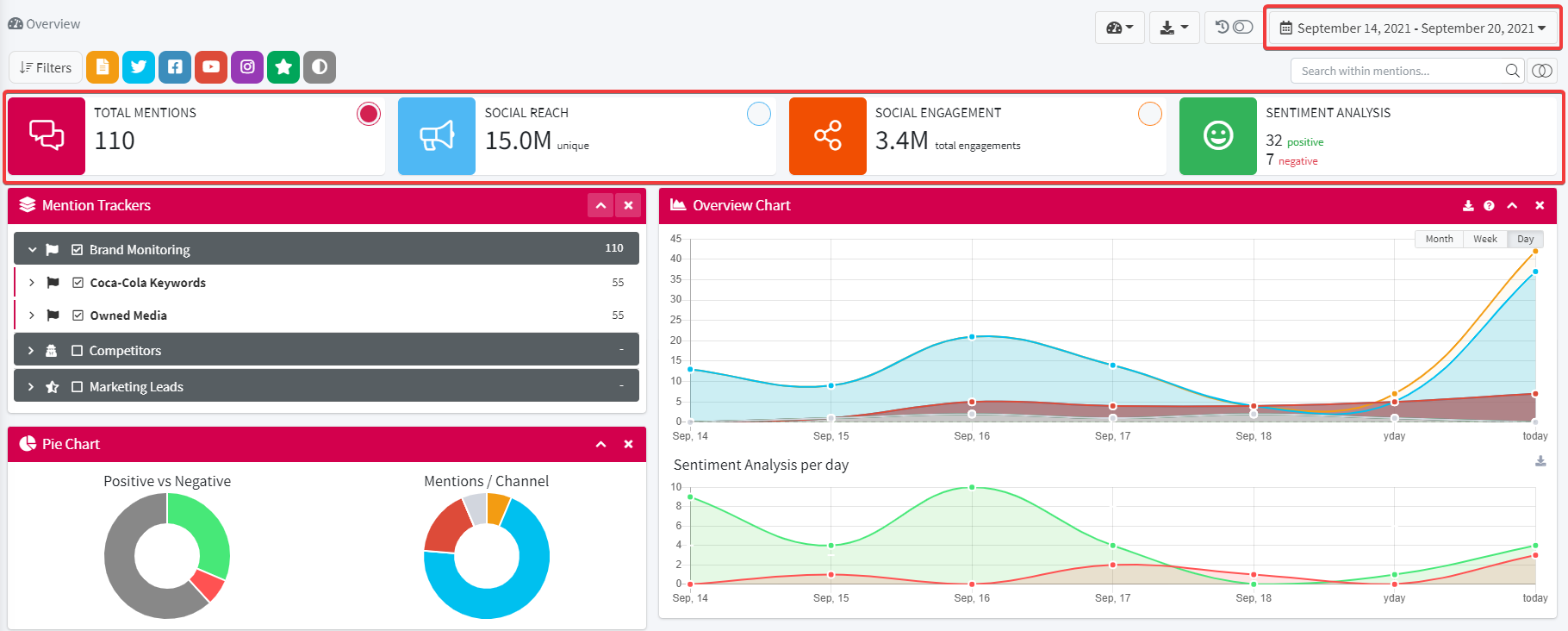
(Coca-Cola brand mentions | Mentionlytics)
6 Steps to create your Keyword Research for Content SEO
1. Make a list of all the keywords your business competes
To begin with, first, try to understand more about your business. Gather all your creative team, invite clients and investors to a workshop. Lead a brainstorming session and try to figure out for which topics or subjects your brand would like to compete.
At this step don’t worry much about search volumes, how competitive the keywords are, or how much people are ranking for them. We just want to brainstorm a list of starting topics that will later help us to research our keywords. Spend sufficient time together with the creative team and try to come up at least with 10 different topics.
For example, let’s use our pastry bakery example from earlier. So the keywords list might look something like this:
- “local bakery”
- “pastry bakery”
- “best bakery”
- “pastry recipes”
- “bakery recipes”
2. Research keywords using created topics
After the brainstorm session, you’ll be left with a decent amount of topics and that will be a great start to start making your keyword list.
At this step take one topic from the bucket list and research keyword list from it. Here we like using Google Keyword Planner to get some initial ideas from our list.
After running a quick keyword search on Google Keyword Planner we get some interesting suggestions we could put in our lists. Repeat the same process over and over again to the remaining topics we created earlier. Lastly, gather a huge list of different keywords you would like to target.
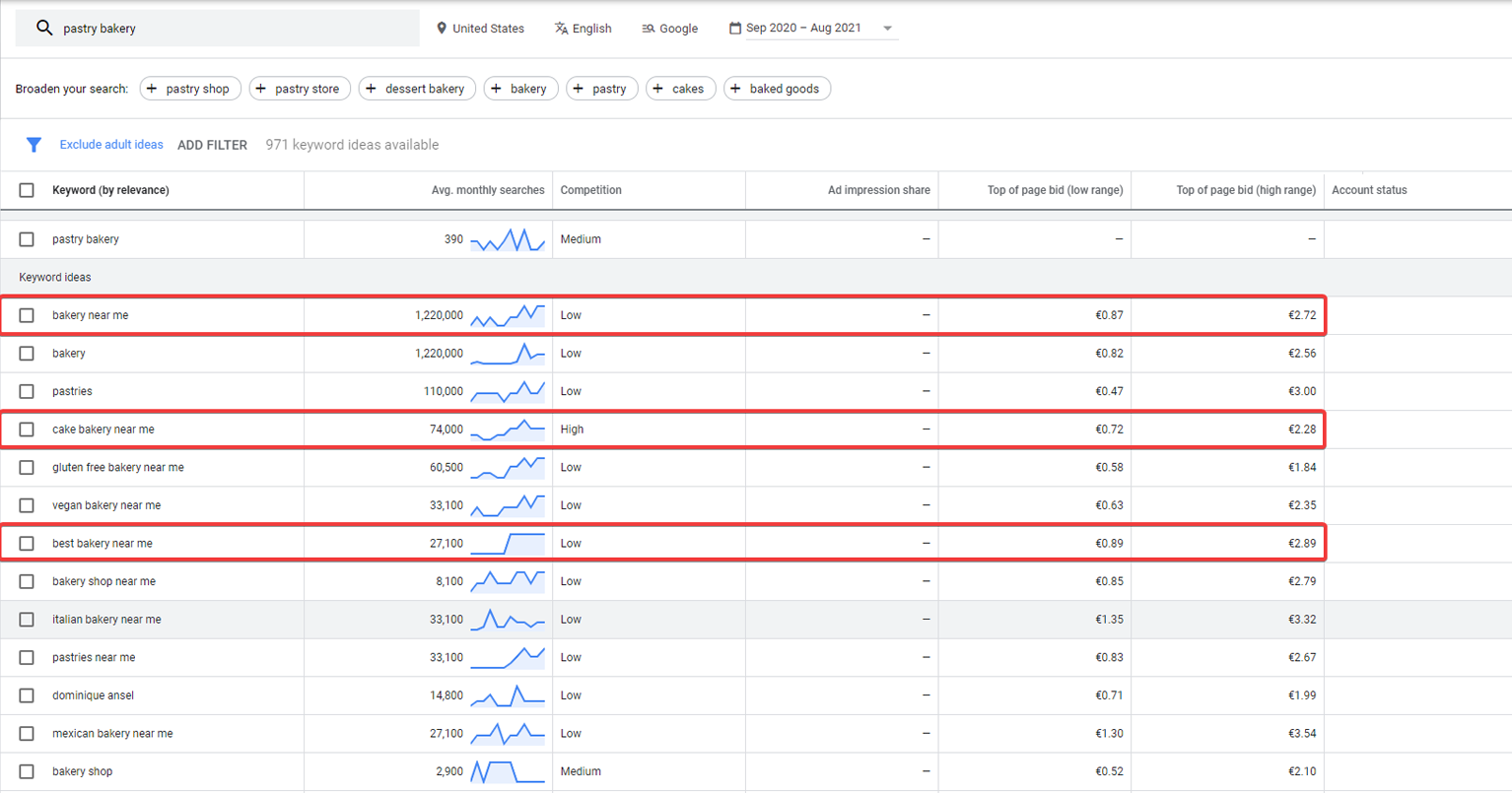
(Keyword suggestion add to the list | Google Keyword Planner)
Finally, don’t forget to research what keywords your competitors are ranking for. This can give you better insights into your competition and how they build their keyword research strategy. However, don’t forget that PPC campaign keyword lists and SEO keyword lists aren’t the same, therefore your lists can differ from your competition.
3. Research the relevance of the keyword
Now it’s time to build the right keywords strategy that will benefit your business in the long term. It’s important to think over several different criteria, such as their Relevance, Volume, Type, and Competitiveness.
Relevance
Keyword relevance, or better known as search intent is a big one to Google. After all, one of Google’s top missions is to help sort worlds data, and search intent relevance exactly helps to do that.
In short, it’s the process that tracks the search intent and how relevant the information is to meet the customer’s needs. Next to that help them to find answers to their problems. The more on-spot your search intent, the higher your content will rank in the search engines.
Despite that, Google’s one of the key goals is to provide customers with the top search quarries to their problems. And it wouldn’t make much sense to rank poorly written content higher than well constructed and researched pieces.
Volume
Keywords search volume is one of the most basic metrics to sort your keywords, though it cannot be ignored. Search volume is a metric that shows how much traffic potentially can visit your website. Just imagine for a second that you’re running your bakery business and rank for the keyword “local bake-house” instead of “local bakery”. Without a doubt, you will experience lower traffic coming to your site while ranking for the first keyword.
Keywords search volume is measured by monthly search volume and tracks how many times the particular keyword has been searched on a monthly basis.
Different Keyword Types
There are 3 different keyword types marketers like to use in their campaigns, that’s Head, Body, and Long-tail keywords.
(Different type of keywords search volume | Ahrefs Blog)
Head Keywords
It’s the most competitive keyword type of all categories because it’s made of a single term. Often, these terms define the top subjects within the industry and in our bakery example it could be terms such as “donuts”, “pastries” or “pies”. Differently from others, they have the biggest search volume.
The only downside is that these terms usually have low conversion rates and don’t define users-intent. For example, it doesn’t really tell much when the person looking for “donuts” is interested to buy them or just wants a recipe.
Body Keywords
The following keywords are the better target option because they tell much more about the user’s search intent and are less competitive. Body keywords are usually between 2 to 3 keyword phrases to form a user quarry. On the other hand, their search volume is much smaller than head terms and it’s around 2,000 searches per month.
In our example, it could be something along the lines such as “pastry recipes” or “chocolate donuts recipe”. Despite them having a smaller search volume than head keywords, they still hold a decent amount of people looking for the phrases.
Long-tail Keywords
Lastly, long-tail keywords are long phrases, usually longer than 4+ words, and are very specific. Generally speaking, they have the lowest competition within all keyword types and are the cheapest to rank. On the other hand, their search volume is the smallest. That ranges between 10-200 monthly searches for particular terms.
Phrases such as “fresh donuts from a local bakery” or “best apple pie recipe from scratch” are the best examples of long-tail keywords. Ranking for terms like this usually gets the highest search intent and there’s a huge chance you’ll be placed on the top search pages for that particular term.
Lastly, it’s doesn’t really matter much which keywords strategy you’ll chose, and what’s most important is to diversify your keywords. That means don’t put all your bets on a single type and go all-in on long-tail keywords because you won’t get any traffic. Make sure to rank for several head keywords, include a few bodies, and finish your strategy with long-tail keywords. And don’t forget that at this stage your workflow shouldn’t be static and once you’ve created the keywords list, update it once you learn more about your customers and what they’re looking for.
4. Research related search keywords
Sometimes it can be that during the keyword research process we just run out of creative juice and start struggling to come up with new keywords.
One of the ways to spark some creativity is to look for related search terms on popular search engines such as Google or Microsoft Bing. Just type in several keywords from your former list and see what results you’ll get.
And if you want to dive slightly deeper, check what related search results you’ll get after you click on one of the related search terms on the first page.
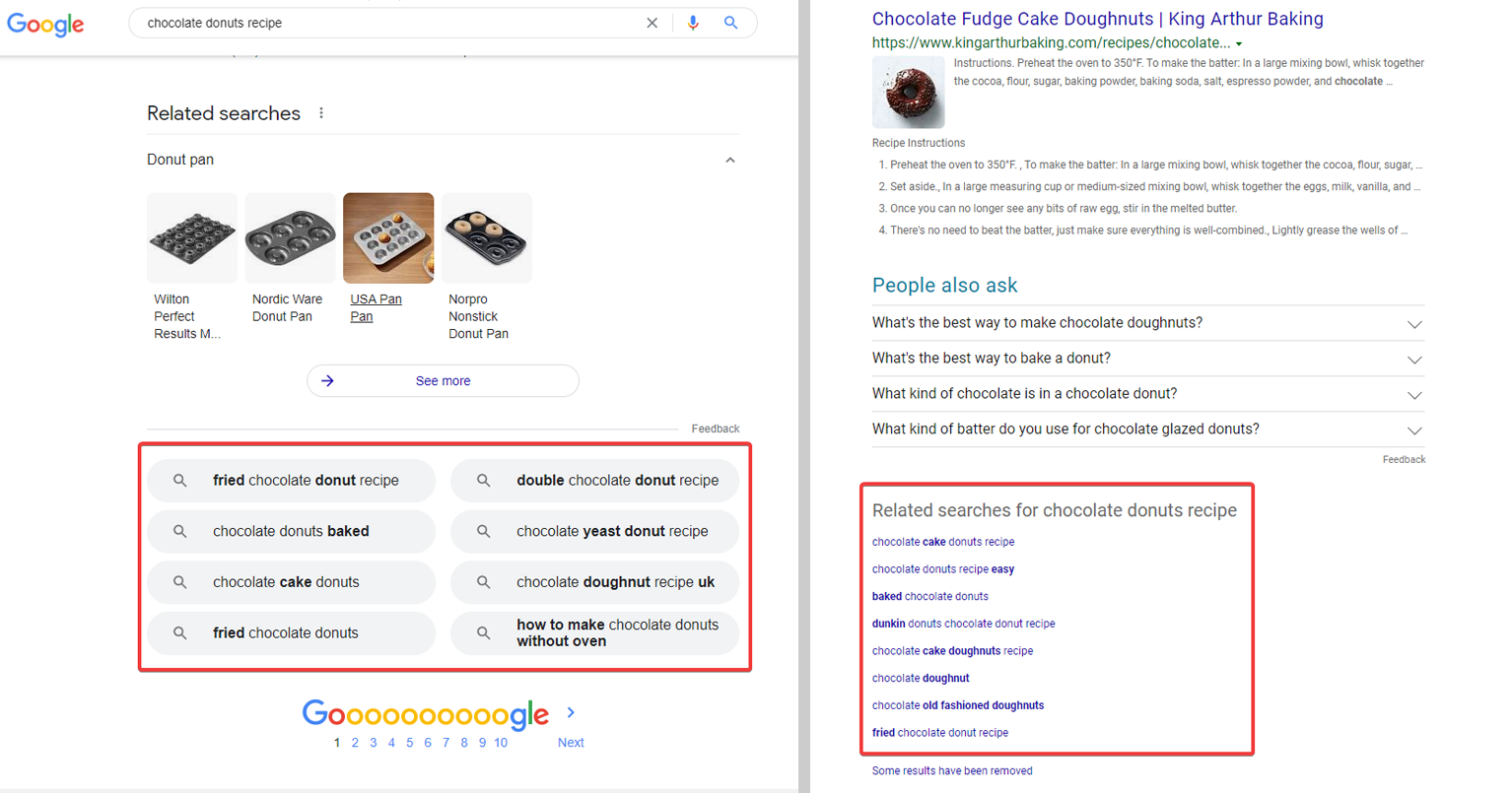
(Google vs Bing related search keyword comparison)
5. Use Google and Youtube Suggest
Another threat method how to spark more creativity in your workflow is to use Google and Youtube auto-suggest features. It happens so that Alphabet Inc. is the parent company of both Google and Youtube and these 2 are the biggest search engines at this moment ranking 1st and 2nd respectively.
The basic technique here is to go to Google or Youtube and type several keywords from your list without pressing anything. Analyze the suggestions from the dropdown menu. Take the keywords you like and research them in other keyword tools. Analyze what’s their search volume and how competitive they are.
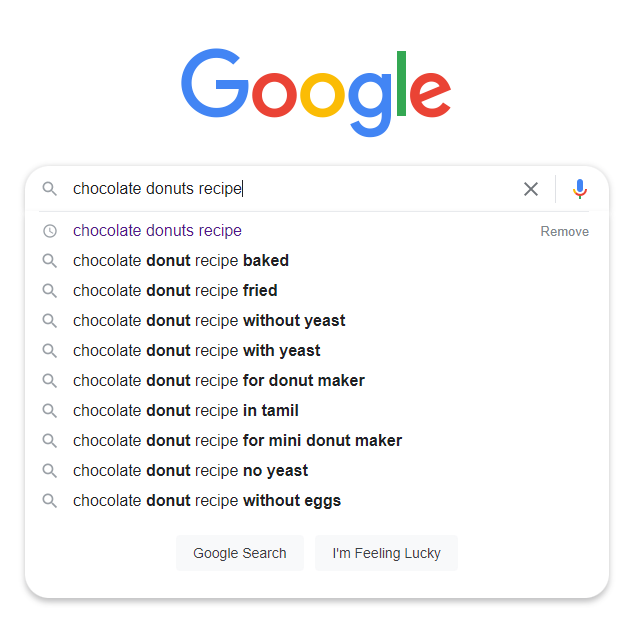

(Google & Youtube auto-suggest feature)
6. 3 Keyword research tools
The keyword research process done manually can become quite time and energy-consuming. Luckily, there are always solutions to speed up the process. Among several free tools such as Google Keyword Planner, there are many other great tools that will ease your workflow of keyword research.
1. Ahrefs Keyword Explorer
Ahrefs is one of the best industry tools used for keyword research SEO and is recommended by many experts.
Different from other tools, it gives you a very detailed keyword research analysis. It includes a breakdown of the search engine first-page competition and how many customers can end up clicking on the final results.
Why Ahrefs Keyword Explorer stands out from the competition is that it provides in-depth keyword difficulty analysis and estimates of the approximate amount of backlinks you’ll need to rank on the first page of Google.

(Ahrefs Keyword Explorer overview | Ahrefs Keyword Explorer)
2. Moz Keyword Explorer
This keyword research tool does all the basics like the other remaining tools. However, what really stands out from the crowd is that it’s truly great at helping you to find the lateral phrases.
For instance, if you’ll look for the keyword “chocolate donuts recipes” you will get something completely different from the rest. It can be something such as “gluten-free chocolate donuts with glaze”.
Next to that, it has several features that are unique to Moz Keyword Explorer, and no other tool has it. That’s Organic CTR, which shows the number in percentages of clicks you can expect to get if you would end up in the top 10 on search engine positions.
Another metric worth mentioning out is Priority which takes CTR, search volume, and keyword difficulty into account and finds the average number. As the result, it provides an “overall” score of whether or not you should be targeting the particular keyword phrase or it’s better to avoid it for now.
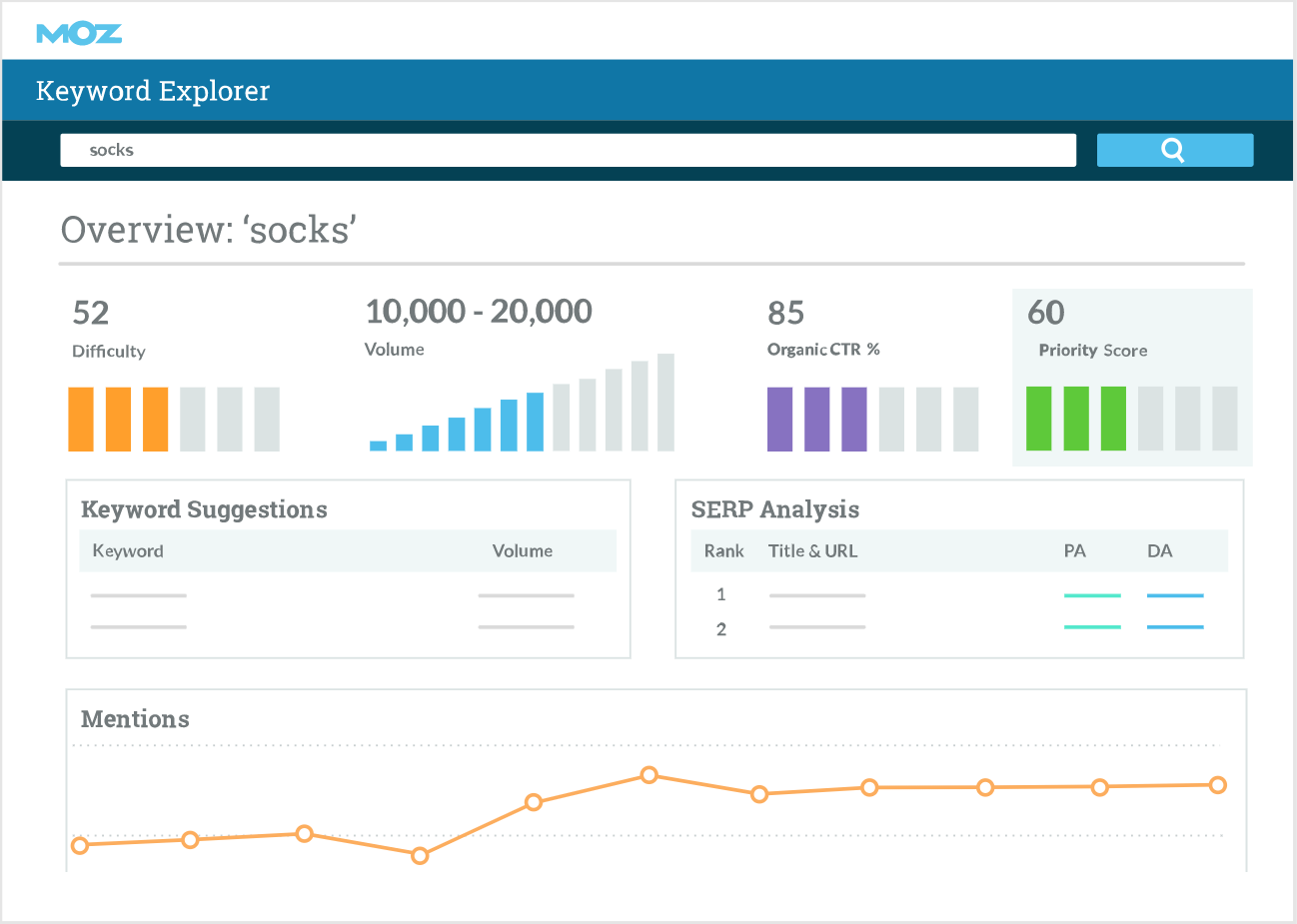
(Moz Keyword Explorer overview | Moz Keyword Explorer)
3. SEMrush
SEMrush is one of the industry-standard tools and is quite admired among many marketers. However, it works slightly differently than the rest of the tools and instead you entering the seed keyword it shows what keywords your competition is ranking for. You just type in their website, the location you want to get from and almost instantly you get the suggestions.
Next to that, it provides you with organic search traffic results and includes several other metrics such as SEMrush Rank which shows where the site ranks in SEMrush’s database. Keywords estimates, which is the number based on monthly organic visitors from Google. And Traffic costs is an approximate amount of how valuable this traffic would be for your business.
Lastly, the SEMrush tool has a feature called Keyword Magic Tool that pulls keyword suggestions from their massive database of 800+ million terms.

(SEMrush Keyword Research overview | SEMrush Keyword Research)
Bonus Point
Advanced Keyword Research through GSC
Google Search Console is a powerful tool that can help you optimize your content to get more leads to your site and it’s completely Free.
It’s very useful to use with your SEO keyword research strategy and update your content to rank better.
So let me quickly explain how it works.
First head to your website Google Search Console, go to Performance > Discover. The following report shows what keywords brought the most traffic to your site from Google.
Next, sort them out by impressions and compare the ratio between the clicks and impressions.
Content pieces that have higher impression rates than clicks aren’t performing well and need optimization.
Depending on content types, such as blog post or product page, go back to it, rewrite, redesign the page to look more exciting, and test again the results.
All in all, you already see that these content pieces generate huge traffic and that’s what people are looking for. So once you’ll optimize them for conversions you’ll make a killing off it. Therefore it’s a very powerful strategy to try out.
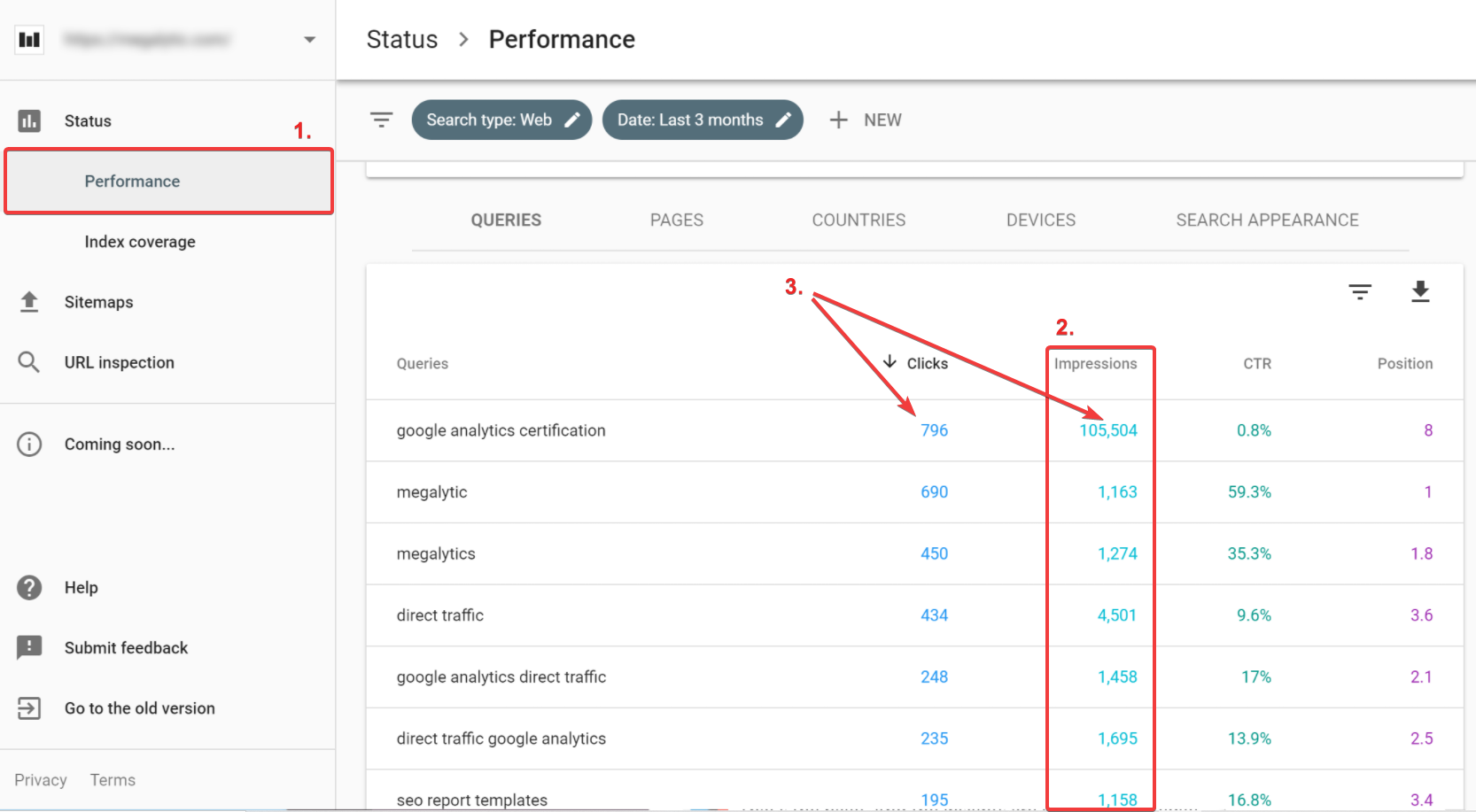
(Google Search Console overview | Google Search Console)
Conclusion
To sum up, that your website would generate traffic and would remain competitive, differently from 91% of dying websites, it’s important to work on a healthy keyword research strategy for SEO. That will help your business to laser focus on keywords you want to rank over time and give you great ideas for content creation.
Therefore, as long as SEO will be around each business needs to work on a keyword research strategy.
And the process is straightforward here. Start with a quick brainstorm session and generate from 10 to 15 topics you want your business to rank.
Then research all these subjects in Google Keyword Planner and start building your keywords list. If you wish you can use other tools such as Ahrefs or Moz Keyword Explorers, or SEMrush tool.
After the thinking process of what keyword research strategy you want to build. Think over keywords Relevance or Intent, Search Volume, and Type of Keyword. Always keep a healthy balance between head, body, and long-tail keywords.
In addition, if you run out of creative juice and struggling to come up with new keyword ideas, use Google-related searches and Youtube suggest features. That will give you new ideas to work on your strategy.
And lastly, don’t forget to use Google Search Console from time to time and optimize your content to convert well.
If you wish to learn more about Search Engine Optimization with smart marketing strategies including keywords research, make sure to check out this great and up-to-date book by industry expert Adam Clarke and his book “SEO 2019 Learn Search Engine Optimization With Smart Internet Marketing Strategies”.







